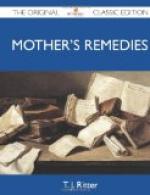Modes of Infection.—The danger of infection depends entirely upon the mode of preparation of the flesh. Thorough cooking, so that all parts of the meat reach the boiling point, destroys the parasites; but, in larger joints, the central portions are not often raised to this temperature. The frequency of the disease in different countries depends largely upon the habits of the people in the preparation of pork. In North Germany, where raw ham and wurst are freely eaten, the greatest number of instances have occurred. In South Germany, France, and England cases are rare. Salting and smoking the flesh are not always sufficient, and the Havre experiments showed that animals are readily infected when fed with portions of the pickled or the smoked meat as prepared in this country.
[52 Mothers’ remedies]
Symptoms.—The eating of trichinous flesh is not always followed by this disease.
In the course of a few days after eating the infected meat there are signs of disturbance of the stomach and bowels, and pain in the abdomen, loss of appetite, vomiting and sometimes diarrhea; and yet, these preliminary symptoms do not always occur, for in some of the large epidemics cases have been observed in which they have been absent. Pain in different parts of the body, general debility and weakness have been noted in some of the epidemics. In some instances the stomach and bowel disturbances have been so marked from the outset that the attack resembled our cholera. The invasion symptoms develop between the seventh and tenth day. Sometimes not until the end of the second week, and they are marked by fever, a chill in some cases and pain and swelling and tenderness along the muscles involved. The migration of the parasites into the muscles excites a more or less intense inflammation of these muscles, which is characterized by pain on pressure and movement, and by swelling and tension of the muscles, over which the skin may be swollen. The limbs are placed in some position in which these muscles are more at rest. Difficulty in chewing and swallowing is caused by the involvement of the muscles controlling these acts. In severe cases the involvement of the diaphragm and intercostal muscles may lead to difficult breathing (Dyspnoea) which sometimes proves fatal. Watery swelling, a feature of great importance, may be seen early in the face, particularly about the, eyes. Later it develops in the extremities when the swelling and stiffness of the muscles are at their height. Profuse sweats, tingling and itching of the skin and in some instances hives (Urticaria) have been described.
There are emaciation and anemia. In the severe cases the appearance may be like that in the third week of typhoid fever. In mild cases the fever and muscular symptoms subside in ten to fourteen days, in others only after two or three months. The mortality, from one to thirty per cent, seems to depend upon the virulence and number of parasites.




